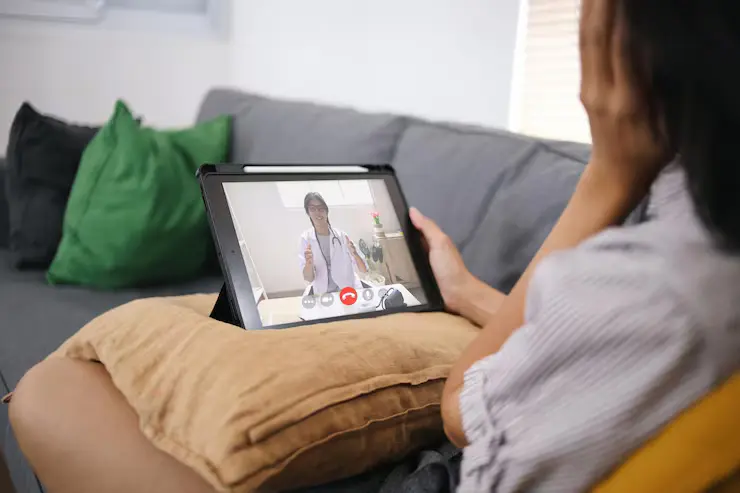
Telehealth medicinal cannabis is rapidly growing in Australia. Medical clinics and pharmacies are slowly adopting telehealth and telemidicine. Whether you’re a telehealth clinic owner, prescriber, or dispensary manager, understanding when to use phone consultations or video appointments can significantly improve your medical cannabis telehealth outcomes and enhance patient experience.
In a country like Australia, with strict rules and regulations for medicinal cannabis, providing effective remote care while also maintaining regulatory compliance and clinical excellence can be challenging. In this blog, we will discuss the differences, challenges and benefits of consulting through phone and video.
What Is Telehealth in Medical Cannabis Care?
Telehealth in medical cannabis is similar to regular telehealth.
Medical cannabis telehealth refers to clinical services and prescription services through telecommunications technology, specifically categorised for the unique requirement of cannabis medicine. Telehealth cannabis service provides patients with quick services and engagement with digital platforms, enabling assessment, prescription, and follow-up care without physical presence.
In the context of Australia, cannabis telehealth should be under a distinct regulation followed by the Therapeutic Goods Administration(TGA) and the AHPRA. These regulations require specific eligibility criteria for remote consultations, documentation standards, and prescription protocols that differ from general telehealth practices. At the same time, the Office of Drug Control(ODC) regulates cultivation and manufacturing.
Benefits and Limitations of Phone Consultations
Phone telehealth consultations offer unique advantages in the medical cannabis telehealth space, particularly for practices serving diverse patient demographics across Australia.
Advantages of Phone Consultations:
- Enhanced accessibility: Reaches patients in rural or low-bandwidth areas where video isn’t feasible
- Lower technological barriers: Ideal for older patients or those with limited digital literacy
- Reduced anxiety: Some patients feel more comfortable discussing cannabis treatment without being on camera
- Streamlined workflows: Typically shorter duration than video visits, allowing more efficient scheduling
- Flexibility: Patients can connect from virtually anywhere with cellular service
Limitations to Consider:
- Absence of visual assessment: Cannot observe physical symptoms, patient appearance, or environment
- Potential communication barriers: Missing non-verbal cues may lead to misunderstandings
- Documentation challenges: More difficult to verify identity and obtain visual confirmation of consent
- Educational limitations: Cannot demonstrate product usage techniques or show educational materials
Best Practices for Phone Consultations:
- Develop structured scripts that ensure consistent assessment and documentation for telehealth cannabis prescription sessions
- Implement EHR templates specific to phone consultations to maintain thorough records
- Conduct regular call quality audits to identify improvement opportunities
- Utilise verbal teach-back methods to confirm patient understanding
- Establish clear protocols for when to escalate from phone to video consultation
For telehealth cannabis clinics focusing on maintenance therapy or serving remote communities, phone consultations can be a valuable modality when implemented with appropriate protocols and quality measures.
Benefits and Limitations of Video Consultations
Video telehealth offers distinct advantages for medicinal cannabis telehealth practitioners seeking to provide comprehensive care while maintaining meaningful patient connections.
Advantages of Video Consultations:
- Visual assessment capabilities: Enables observation of physical symptoms, mobility, and overall presentation
- Enhanced rapport building: Face-to-face interaction fosters stronger therapeutic relationships
- Improved adherence monitoring: Visual verification of proper medication usage and technique
- More thorough evaluations: Ability to observe environmental factors that may impact treatment
- Educational opportunities: Can demonstrate product usage, dosing techniques, and show educational materials
Limitations to Consider:
- Technical requirements: Demands a stable internet connection and compatible devices
- Privacy considerations: Patients must have a private space for consultations
- Digital literacy barriers: Some patients struggle with video platform navigation
- Consultation preparation: Requires attention to provider environment, lighting, and camera setup
- Platform selection complexity: Must choose solutions compliant with Australian privacy standards
Best Practices for Video Consultations:
- Implement secure, healthcare-specific platforms with end-to-end encryption for telehealth cannabis clinic sessions
- Establish protocols for optimal lighting, camera positioning, and professional backgrounds
- Develop comprehensive consent procedures that address recording and privacy concerns
- Create backup plans for technical difficulties, including alternative connection methods
- Train providers on “webside manner” to maintain professionalism and engagement
When examining telemedicine vs telehealth for cannabis practices, video consultations are particularly valuable for initial assessments, complex cases, and situations requiring visual confirmation of symptoms or treatment response in the medical cannabis journey.

Key Clinical Workflows: Phone vs Video
Implementing effective telehealth cannabis workflows requires strategic decisions about when to utilise phone versus video modalities throughout the patient journey.
Intake and Triage Considerations:
- Initial screening: Phone consultations work well for preliminary eligibility screening and basic information gathering
- New patient consultations: Video is typically preferred for comprehensive initial assessments in telehealth medical cannabis practices
- Returning patients: Phone may be sufficient for stable patients with good adherence
- Complex cases: Video consultations should be prioritised for patients with multiple conditions or complex symptom presentations
Documentation Standards by Modality:
- Phone documentation: Must include detailed verbal consent, identity verification methods, and comprehensive symptom descriptions
- Video documentation: Should note visual observations, environmental factors, and confirmation of patient identity through visual means
Both modalities require thorough documentation of treatment plans, education provided, and follow-up scheduling
E-Prescribing Integration:
- Implement secure e-prescribing portals that integrate with both phone and video workflow systems for medicinal cannabis telehealth
- Establish verification protocols for both modalities before prescription transmission
- Create clear documentation pathways that connect telehealth notes directly to prescription records
- Develop dispensary communication protocols to ensure seamless fulfilment regardless of consultation type
By establishing clear decision matrices for when to use each modality and creating standardised workflows for both, telehealth cannabis Australia practices can optimise efficiency while maintaining high-quality care standards.

Ensuring Compliance and Privacy in Cannabis Telehealth
Maintaining regulatory compliance and protecting patient privacy are paramount concerns in telehealth cannabis prescription practice, especially within the Australian regulatory framework.
Data Security Requirements:
- Implement platforms that align with Australian privacy legislation and TGA guidelines
- Ensure end-to-end encryption for all patient communications
- Establish secure document sharing protocols for treatment plans and educational materials
- Conduct regular security audits and vulnerability assessments
- Train all staff on proper data handling procedures specific to cannabis telehealth
Identity Verification Protocols:
- Phone consultations: Implement multi-factor authentication using personal identifiers and security questions
- Video consultations: Require visual verification of government-issued identification
- Both modalities: Document verification methods used in each encounter
- Develop special protocols for proxy appointments (caregivers, translators, etc.)
Record Retention Best Practices:
- Maintain comprehensive documentation of all telehealth encounters according to Australian healthcare requirements
- Implement automated backup systems for all electronic records
- Establish clear retention periods that comply with both healthcare and cannabis-specific regulations
- Create audit-ready filing systems that facilitate quick retrieval during TGA reviews
- Develop incident response protocols for potential data breaches
By prioritising compliance and privacy from the outset, telehealth cannabis clinic providers can build patient trust while avoiding costly regulatory penalties and maintaining practice integrity.
Technology and Platform Selection Best Practices
Selecting the right technology infrastructure is critical for successful telehealth medical cannabis implementation in Australia.
Essential Platform Features:
- End-to-end encryption that meets Australian healthcare security standards
- Seamless integration with electronic health records and point-of-sale systems
- Mobile support for both providers and patients
- Scheduling capabilities with automated reminders
- Documentation templates specific to cannabis assessments
- Capacity for secure messaging between appointments
Leading Solution Comparisons
When evaluating Video Calling platforms for your telehealth cannabis Australia practice, consider factors specific to cannabis practice:
- Cannabis-specific templates and assessment tools
- Integration capabilities with dispensary systems
- Compliance features for specialised documentation
- Patient education resource libraries
- Multi-provider scheduling for team-based care
Scalability Considerations
- Select platforms that accommodate growth in patient volume
- Ensure solutions support multiple providers with varied schedules
- Consider interoperability with other clinical systems
- Evaluate reporting capabilities for quality monitoring
- Assess vendor support for ongoing training and implementation
2025’s regulatory warnings from AHPRA
- Aggressive marketing strategies by cannabis clinics
- Extremely brief consultations (some lasting only seconds)
- Over-prescribing patterns (some practitioners issuing over 17,000 scripts in six months)
The ideal platform balances robust functionality with user-friendly interfaces for both providers and patients, while maintaining the specialised features needed for cannabis telehealth compliance and clinical excellence in the Australian healthcare context.
Training Your Team for Phone and Video Consultations
Comprehensive staff training is essential for telehealth success in the medical cannabis telehealth space.
Phone Consultation Training
- Develop standardised scripts addressing common cannabis-related inquiries for telehealth cannabis prescription services
- Conduct role-playing exercises focusing on clear verbal communication
- Train providers on active listening techniques that compensate for missing visual cues
- Implement call recording (with consent) for training and quality improvement
- Create response protocols for managing difficult conversations or crisis situations
Video Consultation Best Practices
- Establish professional environment standards (background, lighting, camera angle)
- Train on effective “webside manner” including eye contact and engagement techniques
- Guide visual assessment strategies for cannabis patients
- Develop troubleshooting protocols for common technical issues
- Create standards for professional appearance and presentation
Ongoing Quality Improvement
- Implement regular peer review of recorded sessions (with appropriate consent)
- Establish key performance indicators for both phone and video consultations
- Create feedback mechanisms for patients to evaluate their telehealth experience
- Schedule regular training updates as technologies and regulations evolve
- Develop mentorship programs pairing experienced telehealth providers with new team members
Investing in comprehensive training ensures consistent, high-quality care delivery regardless of consultation modality, while building team confidence in the telehealth environment for medicinal cannabis telehealth practices.
Measuring Success: KPIs and Patient Feedback
Implementing robust measurement systems is essential for optimising telehealth performance in telehealth cannabis clinics.
Key Performance Indicators
- Operational metrics: No-show rates, consultation duration, technical issue frequency
- Clinical outcomes: Symptom improvement, medication adherence, adverse event reports
- Patient engagement: Follow-up compliance, portal usage, education resource access
- Provider efficiency: Patients per day, documentation completion time, prescription processing speed
- Financial performance: Revenue per telehealth visit, cost per consultation, reimbursement rates
Measurement Tools
- Post-visit satisfaction surveys specific to telehealth modality
- Net Promoter Score (NPS) tracking to measure loyalty and recommendation likelihood
- Telehealth utilisation dashboards showing usage patterns by modality
- Clinical outcome tracking comparing phone vs. video consultation results
- Technical performance monitoring to identify and address system issues
Continuous Improvement Framework
- Establish baseline measurements before implementing changes
- Set specific improvement targets for key metrics
- Implement regular review cycles to assess performance
- Create action plans addressing identified shortcomings
- Celebrate and share successful strategies across the practice
By systematically measuring telehealth performance and gathering structured patient feedback, cannabis telehealth practitioners can continuously refine their approach to remote care delivery.
Conclusion
Telehealth medical cannabis offers transformative potential when practitioners strategically implement both phone and video consultation modalities. As we’ve explored throughout this guide, phone consultations excel in accessibility and efficiency, while video consultations provide clinical depth and enhanced rapport-building. Together, they create a flexible framework for comprehensive telehealth cannabis care.
Due to the strict regulations and compliance mandatory in Australia, telehealth should follow the rules and regulations, also ensuring a better user experience for patients. Cannabiz Elite can help you with the best custom compliant software in Australia at a very reasonable price. Contact us now or book a demo for a better understanding of your services.
Frequently Asked Questions(FAQs)
What is the main difference between RPM and RTM?
RPM collects physiological data (like heart rate) using medical devices, while RTM gathers non-physiological, self-reported data (such as therapy adherence or symptom tracking).
Can you use Zoom for telehealth?
Yes, Zoom offers HIPAA-compliant plans suitable for telehealth if a business associate agreement is signed and privacy standards are maintained.
What is the future of RPM in the next two years?
Remote patient monitoring (RPM) is expected to grow rapidly, with global users projected to exceed 115 million by 2027 and adoption driven by AI, wearables, and expanded virtual care services.
What is the difference between telehealth and telemedicine?
Telemedicine refers just to remote clinical (medical) services, while telehealth covers both clinical and non-clinical services such as education, administration, and training.
What is telehealth in short?
Telehealth is the use of digital technology to deliver health care and health information remotely.
